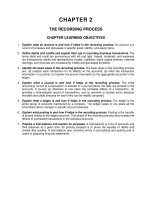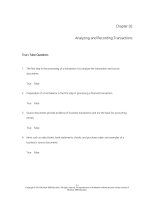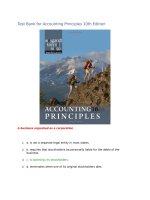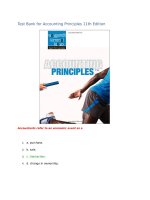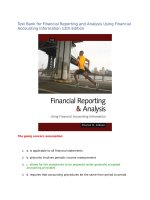Download PDF accounting principles 12th edition weygandt kimmel kieso solutions manual
Bạn đang xem bản rút gọn của tài liệu. Xem và tải ngay bản đầy đủ của tài liệu tại đây (1.12 MB, 63 trang )
Accounting Principles, 12th Edition Weygandt
Kimmel Kieso Solutions Manual
CHAPTER 1
Accounting in Action
ASSIGNMENT CLASSIFICATION TABLE
Learning Objectives
1.
Questions
Identify the activities and 1, 2, 3, 4,
5 users associated with accounting.
2.
Explain the building blocks of 6, 7, 8, 9, 10
accounting: ethics,
principles, and assumptions.
3.
State the accounting
equation, and define
its components.
4.
Brief
Exercises
Do It!
Exercises
1
1, 2
2
3, 4
A
Problems
11, 12, 13, 22 1, 2, 3, 4, 5, 8
3, 5
5
1A, 2A 4A
Analyze the effects of 14, 15, 16, 18 6, 7, 9
business transactions on the accounting equation.
4
6, 7, 8
1A, 2A, 4A,
5A
Describe the four financial
17, 19, 20, 21 10, 11
statements and how they are prepared.
5.
5
9, 10, 11, 12, 2A, 3A, 4A,
13, 14, 15, 16 5A
ASSIGNMENT CHARACTERISTICS TABLE
Problem
Number
Description
Difficulty
Level
Time Allotted
(min.)
1A
Analyze transactions and compute net income.
Moderate
40–50
2A
Analyze transactions and prepare income statement,
owner’s equity statement, and balance sheet.
Moderate
50–60
3A
Prepare income statement, owner’s equity statement, and
balance sheet.
Moderate
50–60
4A
Analyze transactions and prepare financial statements.
Moderate
5A
Determine financial statement amounts and prepare
owner’s equity statement.
Moderate
40–50
40–50
WEYGANDT ACCOUNTING PRINCIPLES 12E
CHAPTER 1
ACCOUNTING IN ACTION
Number
LO
BT
Difficulty
Time (min.)
BE1
3
AP
Simple
2–4
BE2
3
AP
Simple
3–5
BE3
3
AP
Moderate
4–6
BE4
3
AP
Moderate
4–6
BE5
3
C
Simple
2–4
BE6
4
C
Simple
2–4
BE7
4
C
Simple
2–4
BE8
3
C
Simple
2–4
BE9
4
C
Simple
1–2
BE10
5
AP
Simple
3–5
BE11
5
C
Simple
2–4
DI1
1
K
Simple
2–4
DI2
2
K
Simple
2–4
DI3
3
AP
Simple
6–8
DI4
4
AP
Moderate
8–10
DI5
3, 5
AP
Moderate
10–12
EX1
1
C
Moderate
5–7
EX2
1
C
Simple
6–8
EX3
2
C
Moderate
6–8
EX4
2
C
Moderate
6–8
EX5
3
C
Simple
4–6
EX6
4
C
Simple
6–8
EX7
4
C
Simple
4–6
EX8
4
AP
Moderate
12–15
EX9
5
AP
Simple
12–15
EX10
5
AP
Moderate
8–10
EX11
5
AP
Moderate
6–8
EX12
5
AP
Simple
8–10
EX13
5
AN
Simple
8–10
EX14
5
AP
Simple
10–12
EX15
5
AP
Simple
6–8
EX16
5
AP
Moderate
6–8
ACCOUNTING IN ACTION (Continued)
Number
P1A
LO
3, 4
BT
Difficulty
Time (min.)
AP
Moderate
40–50
P2A
3–5
AP
Moderate
50–60
P3A
5
AP
Moderate
50–60
P4A
3–5
AP
Moderate
40–50
4, 5
AP
Moderate
40–50
BYP1
5
AN
Simple
10–15
BYP2
5
AN, E
Simple
10–15
BYP3
5
AN, E
Simple
10–15
BYP4
6
C, AN
Simple
15–20
BYP5
4
E
Moderate
15–20
BYP6
5
E
Simple
12–15
BYP7
2
E
Simple
10–12
BYP8
2
E
Moderate
15–20
P5A
BYP9
–
AP
Moderate
15–20
BYP10
–
C
Simple
10–15
Learning Objective
Knowledge Comprehension
1. Identify the activities and users
associated with accounting.
DI1-1
Q1-1
Q1-2
Q1-3
Q1-4
3. Explain the building blocks of
accounting: ethics, principles,
and assumptions.
Q1-7
Q1-8
Q1-9
Q1-10
DI1-1
Q1-6
E1-3
E1-4
3. State the accounting equation,
and define its components.
DI1-2 BE1- Q1-11
5
Q1-12
Q1-13
BE1-4
BE1-8
4. Analyze the effects of business
transactions on the accounting
equation.
Q1-14
Q1-15
Q1-16
Q1-18
5. Describe the four financial
statements and how they are
prepared.
Q1-17
Q1-19
BE1-11
Broadening Your Perspective
Application
Analysis
Synthesis
Evaluation
Q1-5
E1-1
E1-2
BE1-9 BE1-1
E1-5
BE1-2
BE1-3
DI1-5
P1-1A
P1-2A
P1-4A
BE1-6
BE1-7
E1-6
E1-7
P1-4A
P1-5A
DI1-4
E1-8
P1-1A
P1-2A
Q1-20
E1-14
Q1-21
E1-15
BE1-10 E1-16
DI1-5
E1-17
E1-8
P1-2A
E1-9
P1-3A
E1-10
P1-4A
E1-11
P1-5A
E1-12
FASB
Real–World Focus
Codification
Considering
People, Planet,
and Profit
E1-13
Financial Reporting
Comparative
Analysis
All About You
Comparative Analysis
Decision–Making
Across
the
Organization
Communication
Activity
Ethics Case
ANSWERS TO QUESTIONS
1.
Yes, this is correct. Virtually every organization and person in our society uses accounting
information. Businesses, investors, creditors, government agencies, and not-for-profit
organizations must use accounting information to operate effectively.
2.
Accounting is the process of identifying, recording, and communicating the economic events of
an organization to interested users of the information. The first step of the accounting process is
therefore to identify economic events that are relevant to a particular business. Once identified
and measured, the events are recorded to provide a history of the financial activities of the
organization. Recording consists of keeping a chronological diary of these measured events in an
orderly and systematic manner. The information is communicated through the preparation and
distribution of accounting reports, the most common of which are called financial statements. A
vital element in the communication process is the accountant’s ability and responsibility to
analyze and interpret the reported information.
3.
(a) Internal users are those who plan, organize, and run the business and therefore are officers
and other decision makers.
(b) To assist management, managerial accounting provides internal reports. Examples include
financial comparisons of operating alternatives, projections of income from new sales campaigns,
and forecasts of cash needs for the next year.
4.
(a) Investors (owners) use accounting information to make decisions to buy, hold, or sell
ownership shares of a company.
(b) Creditors use accounting information to evaluate the risks of granting credit or lending money.
5.
No, this is incorrect. Bookkeeping usually involves only the recording of economic events and
therefore is just one part of the entire accounting process. Accounting, on the other hand,
involves the entire process of identifying, recording, and communicating economic events.
6.
Trenton Travel Agency should report the land at $90,000 on its December 31, 2017 balance
sheet. This is true not only at the time the land is purchased, but also over the time the land is
held. In determining which measurement principle to use (cost or fair value) companies weigh the
factual nature of cost figures versus the relevance of fair value. In general, companies use cost.
Only in situations where assets are actively traded do companies apply the fair value principle.
An important concept that accountants follow is the historical cost principle.
7.
The monetary unit assumption requires that only transaction data that can be expressed in terms
of money be included in the accounting records. This assumption enables accounting to quantify
(measure) economic events.
8.
The economic entity assumption requires that the activities of the entity be kept separate and
distinct from the activities of its owners and all other economic entities.
9.
The three basic forms of business organizations are: (1) proprietorship, (2) partnership, and
(3) corporation.
Questions Chapter 1 (Continued)
10.
One of the advantages Rachel Hipp would enjoy is that ownership of a corporation is represented
by transferable shares of stock. This would allow Rachel to raise money easily by selling a part of
her ownership in the company. Another advantage is that because holders of the shares
(stockholders) enjoy limited liability; they are not personally liable for the debts of the corporate
entity. Also, because ownership can be transferred without dissolving the corporation, the
corporation enjoys an unlimited life.
11.
The basic accounting equation is Assets = Liabilities + Owner’s Equity.
12.
(a) Assets are resources owned by a business. Liabilities are claims against assets. Put more
simply, liabilities are existing debts and obligations. Owner’s equity is the ownership claim on
total assets.
(b) Owner’s equity is affected by owner’s investments, drawings, revenues, and expenses.
13.
The liabilities are: (b) Accounts payable and (g) Salaries and wages payable.
14.
Yes, a business can enter into a transaction in which only the left side of the accounting equation
is affected. An example would be a transaction where an increase in one asset is offset by a
decrease in another asset. An increase in the Equipment account which is offset by a decrease in
the Cash account is a specific example.
15.
Business transactions are the economic events of the enterprise recorded by accountants
because they affect the basic accounting equation.
(a) The death of the owner of the company is not a business transaction as it does not affect the basic
accounting equation.
(b) Supplies purchased on account is a business transaction as it affects the basic accounting equation.
(c) An employee being fired is not a business transaction as it does not affect the
basic accounting equation.
(d) A withdrawal of cash from the business is a business transaction as it affects the
basic accounting equation.
(b) Increase assets and decrease assets.
(d) Decrease assets and decrease liabilities.
16.
(a) Decrease assets and decrease owner’s equity.
(c) Increase assets and increase owner’s equity.
17. (a) Income statement. (d) Balance sheet.
(b) Balance sheet. (e) Balance sheet and owner’s equity statement. (c) Income statement. (f) Balance
sheet.
18.
No, this treatment is not proper. While the transaction does involve a receipt of cash, it does not
represent revenues. Revenues are the gross increase in owner’s equity resulting from business
activities entered into for the purpose of earning income. This transaction is simply an additional
investment made by the owner in the business.
Questions Chapter 1 (Continued)
19.
Yes. Net income does appear on the income statement—it is the result of subtracting expenses
from revenues. In addition, net income appears in the owner’s equity statement—it is shown as
an addition to the beginning-of-period capital. Indirectly, the net income of a company is also
included in the balance sheet. It is included in the capital account which appears in the owner’s
equity section of the balance sheet.
20. (a) Ending capital balance .....................................................................................
$198,000
Beginning capital balance ................................................................................
168,000
.......................................................................................................Netincome
$ 30,000
(b) Ending capital balance .....................................................................................
$198,000
Beginning capital balance ................................................................................
168,000
30,000
Deduct: Investment .........................................................................................
13,000
.......................................................................................................Netincome
$ 17,000
21. (a) Total revenues ($20,000 + $70,000)
$90,000
(b) Total expenses ($26,000 + $40,000) ................................................................
$66,000
(c)
22.
Total revenues .................................................................................................
$90,000
Total expenses.................................................................................................
66,000
.......................................................................................................Netincome
$24,000
Apple’s accounting equation at September 28, 2013 was $207,000,000,000 = $83,451,000,000 +
$123,549,000,000.
SOLUTIONS TO BRIEF EXERCISES
BRIEF EXERCISE 1-1
(a) $90,000 – $50,000 = $40,000 (Owner’s Equity).
(b) $44,000 + $70,000 = $114,000 (Assets). (c)
$94,000 – $53,000 = $41,000 (Liabilities).
BRIEF EXERCISE 1-2
(a) $120,000 + $232,000 = $352,000 (Total assets).
(b) $190,000 – $91,000 = $99,000 (Total liabilities). (c) $800,000 –
0.5($800,000) = $400,000 (Owner’s equity).
BRIEF EXERCISE 1-3
(a) ($800,000 + $150,000) – ($300,000 – $60,000) = $710,000
(Owner’s equity).
(b) ($300,000 + $100,000) + ($800,000 – $300,000 – $70,000) = $830,000
(Assets).
(c) ($800,000 – $80,000) – ($800,000 – $300,000 + $120,000) =
$100,000 (Liabilities).
BRIEF EXERCISE 1-4
Owner’s Equity
Assets
(a) X
=
Liabilities
= $90,000
Owner’s
+ Capital
+ $150,000
Owner’s
– Drawings + Revenues – Expenses
– $40,000 + $450,000 – $320,000
X
X
= $90,000
= $330,000
(b) $57,000 =
$57,000 =
X
(c)
+ $240,000
X
X
+ $25,000
+ $35,000
– $7,000
= $22,000 ($57,000 – $35,000)
$600,000 = ($600,000 x 2/3) + X (Owner’s equity)
$600,000 = $400,000
+X
X
= $200,000
+ $52,000 – $35,000
BRIEF EXERCISE 1-5
A (a) Accounts receivable
A (d) Supplies
L (b) Salaries and wages payable OE (e) Owner’s capital
A (c) Equipment
L (f) Notes payable
BRIEF EXERCISE 1-6
Assets
(a)
(b)
(c)
+
+
–
Liabilities
+
NE
NE
Owner’s Equity
NE
+
–
BRIEF EXERCISE 1-7
(a)
(b)
Assets
Liabilities
+
NE
+
– NE – (c) NE NE NE
Owner’s Equity
BRIEF EXERCISE 1-8
E (a) Advertising expense
R (b) Service revenue
E (c) Insurance expense
E (d) Salaries and wages expense
BRIEF EXERCISE 1-9
R (a) Received cash for services performed
NOE (b) Paid cash to purchase equipment
E (c) Paid employee salaries
BRIEF EXERCISE 1-10
D (e) Owner’s drawings
R (f) Rent revenue
E (g) Utilities expense
MENDOZA COMPANY Balance
Sheet
December 31, 2017
Assets
Cash ...............................................................................................
Accounts receivable .....................................................................
............................................................................Totalassets
Liabilities and Owner’s Equity Liabilities
Accounts payable ..................................................................
Owner’s equity
Owner’s capital ......................................................................
...............................Totalliabilitiesandowner’sequity
$ 49,000
72,500
$ 121,500
$ 90,000
31,500
$ 121,500
BRIEF EXERCISE 1-11
BS
(a) Notes payable
IS
(b) Advertising expense
OE, BS (c) Owner’s capital
BS
(d) Cash
IS
(e) Service revenue
SOLUTIONS FOR DO IT! REVIEW EXERCISES
DO IT! 1-1
1.
2.
3.
False. The three steps in the accounting process
are identification, recording, and communication.
True.
False. Financial accounting provides reports to help investors and
creditors evaluate a company.
4. True.
5. True.
DO IT! 1-2
1.
2.
3.
4.
5.
False. Congress passed the Sarbanes-Oxley Act to reduce unethical
behavior and decrease the likelihood of future corporate scandals.
False. The standards of conduct by which actions are judged as
right or wrong, honest or dishonest, fair or not fair, are ethics.
False. The primary accounting standard-setting body in the United
States is the Financial Accounting Standards Board (FASB).
True.
True.
DO IT! 1-3
1.
2.
3.
4.
Drawings is owner’s drawings (D); it decreases owner’s equity.
Rent Revenue is revenue (R); it increases owner’s equity.
Advertising Expense is an expense (E); it decreases owner’s equity.
When the owner puts personal assets into the business, it
is investment by owner (I); it increases owner’s equity.
DO IT! 1-4
Assets
Cash
Owner’s Equity
= Liabilities +
Accounts Accounts
+ Receivable = Payable +
Owner’s
Capital
Owner’s
– Drawings
+ Revenues – Expenses
(1)
(2)
+$20,000
+$20,000 –$20,000
+$20,000
(3)
(4)
+$2,300
–$ 3,600
–$2,300
–$3,600
DO IT! 1-5
(a) The total assets are $49,000, comprised of Cash $6,500,
Accounts Receivable $13,500, and Equipment $29,000.
(b) Net income is $20,500, computed as follows:
Revenues
Service revenue..................................................
Expenses
Salaries and wages expense ............................. $16,500
Rent expense ......................................................
10,500
Advertising expense ..........................................
6,000
Total expenses ...........................................
.................................................................Netincome
$53,500
33,000
$20,500
(c) The ending owner’s equity balance of Kirby Company is $21,000. By
rewriting the accounting equation, we can compute Owner’s Equity as
Assets minus Liabilities, as follows:
Total assets [as computed in (a)].............................Less:
Liabilities
Notes payable .....................................................
$25,000
$49,000
Accounts payable ..............................................
...........................................................
28,000
$21,000
3,000
Note that it is not possible to determine the company’s owner’s equity in
any other way, because the beginning balance for owner’s equity is not
provided.
SOLUTIONS TO EXERCISES
EXERCISE 1-1
C Analyzing and interpreting information.
R Classifying economic events.
C Explaining uses, meaning, and limitations of data.
R Keeping a systematic chronological diary of events.
R Measuring events in dollars and cents.
C Preparing accounting reports.
C Reporting information in a standard format.
I Selecting economic activities relevant to the company.
R Summarizing economic events.
EXERCISE 1-2
(a)
Internal users Marketing
manager Production supervisor
Store manager Vicepresident of finance
External users
Customers
Internal Revenue Service
Labor unions
Securities and Exchange Commission Suppliers
(b)
I Can we afford to give our employees a pay
raise?
E Did the company earn a satisfactory income? I
Do we need to borrow in the near future?
E How does the company’s profitability compare to other companies? I
What does it cost us to manufacture each unit produced?
I Which product should we emphasize?
E Will the company be able to pay its short-term debts?
EXERCISE 1-3
Angela Duffy, president of Duffy Company, instructed Jana Barth, the head
of the accounting department, to report the company’s land in its
accounting reports at its fair value of $170,000 instead of its cost of
$100,000, in an effort to make the company appear to be a better
investment. The historical cost principle requires that assets be recorded
and reported at their cost, because cost is faithfully representative and can
be objectively measured and verified. In this case, the historical cost
principle should be used and Land reported at $100,000, not $170,000.
The stakeholders include stockholders and creditors of Duffy Company,
potential stockholders and creditors, other users of Duffy’s accounting
reports, Angela Duffy, and Jana Barth. All users of Duffy’s accounting
reports could be harmed by relying on information that may be unreliable.
Angela Duffy could benefit if the company is able to attract more investors,
but would be harmed if the inappropriate reporting is discovered. Similarly,
Jana Barth could benefit by pleasing her boss, but would be harmed if the
inappropriate reporting is discovered.
Jana’s alternatives are to report the land at $100,000 or to report it at
$170,000. Reporting the land at $170,000 is not appropriate since it may
mislead many people who rely on Duffy’s accounting reports to make
financial decisions. Jana should report the land at its cost of $100,000. She
should try to convince Angela Duffy that this is the appropriate course of
action, but be prepared to resign her position if Duffy insists.
EXERCISE 1-4
1.
Incorrect. The historical cost principle requires that assets
(such as buildings) be recorded and reported at their cost.
2.
Correct. The monetary unit assumption requires that companies
include in the accounting records only transaction data that can be
expressed in terms of money.
3.
Incorrect. The economic entity assumption requires that the activities
of the entity be kept separate and distinct from the activities of its
owner and all other economic entities.
EXERCISE 1
-5
Asset
Liability
Cash
Equipment
Supplies
Accounts receivable
Accounts payable
Notes payable
Salaries and wages
payable
Owner’s Equity
Owner’s capital
EXERCISE 1-6
1.
2.
3.
4.
5.
6.
7.
8.
9.
Increase in assets and increase in owner’s equity.
Decrease in assets and decrease in owner’s equity.
Increase in assets and increase in liabilities.
Increase in assets and increase in owner’s equity.
Decrease in assets and decrease in owner’s equity.
Increase in assets and decrease in assets.
Increase in liabilities and decrease in owner’s equity.
Increase in assets and decrease in assets.
Increase in assets and increase in owner’s equity.
EXERCISE 1-7
1.
2.
3.
4.
(c)
(d)
(a)
(b)
EXERCISE 1-8
5. (d)
6. (b)
7. (e)
8. (f)
(a) 1.Owner invested $15,000 cash in the business.
2.
Purchased equipment for $5,000, paying $2,000 in cash and the
balance of $3,000 on account.
3.
Paid $750 cash for supplies.
4.
Performed $8,500 of services, receiving $4,600 cash
and $3,900 on account.
5.
Paid $1,500 cash on accounts payable.
EXERCISE 1-8 (Continued)
6.
7.
8.
9.
10.
Owner withdrew $2,000 cash for personal use.
Paid $650 cash for rent.
Collected $450 cash from customers on account.
Paid salaries and wages of $4,800.
Incurred $400 of utilities expense on account.
(b) Investment ...............................................................................
Service revenue ......................................................................
Drawings .................................................................................
Rent expense ..........................................................................
Salaries and wages expense .................................................
Utilities expense .....................................................................
.....................................................Increaseinowner’sequity
(c) Service revenue ......................................................................
$15,000
8,500
(2,000)
(650)
(4,800)
(400)
$15,650
$8,500
Rent expense ..........................................................................
(650)
Salaries and wages expense .................................................
(4,800)
Utilities expense .....................................................................
(400)
EXERCISE 1
Net income ..............................................................................
$2,650
EXERCISE 1-9
ARTHUR COOPER & CO.
Income Statement
For the Month Ended August 31, 2017
Revenues
Service revenue .........................................................
Expenses
Salaries and wages expense ....................................
Rent expense .............................................................
Utilities expense ........................................................
Total expenses ...................................................
.........................................................................Netincome
$8,500
$4,800
650
400
5,850
$2,650
9 (Continued)
ARTHUR COOPER & CO.
Owner’s Equity Statement
For the Month Ended August 31, 2017
Owner’s capital, August 1 ............................................
Add: Investments .......................................................
Net income .........................................................
Less: Drawings ............................................................
..........................................Owner’scapital,August31
ARTHUR COOPER & CO.
Balance Sheet
$
$15,000
2,650
0
17,650
17,650
2,000
$15,650
August 31, 2017
Assets
.......................................................................................
receivable ......................................................................
.......................................................................................
t ......................................................................................
............................................................................ts
Liabilities and Owner’s Equity Liabilities
unts payable ..................................................................
quity
r’s capital ......................................................................
...............................otalliabilitiesandowner’sequity
$ 8,350
3,450
750
5,000
$17,550
$ 1,900
15,650
$17,550
1-10
s equity—12/31/16 ($400,000 – $250,000) .................
r’s equity—1/1/16 ..........................................................
se in owner’s equity ....................................................
Drawings .....................................................................
...............................................................comefor2016
$150,000
100,000
50,000
15,000
$ 65,000
ISE 1
10 (Continued)
(b) Owner’s equity—12/31/17 ($460,000 – $300,000)
Owner’s equity—1/1/17—see (a) .........................................
Increase in owner’s equity ..................................................
Less: Additional investment ..............................................
..................................................................
$160,000...............
150,000
10,000
45,000
$ (35,000)
$190,000
(c) Owner’s equity—12/31/18 ($590,000 – $400,000)
Owner’s equity—1/1/18—see (b) .........................................
Increase in owner’s equity ..................................................
Less: Additional investment ..............................................
...............
160,000
30,000
15,000
15,000
25,000
$ 40,000
Add: Drawings ...................................................................
.............................................................
EXERCISE 1-11
(a) Total assets (beginning of year) .........................................
Total liabilities (beginning of year) .....................................
$110,000
85,000
...........Totalowner’sequity(beginningofyear)
(b) Total owner’s equity (end of year)
Total owner’s equity (beginning of year)
..................................................
......................................
...........................
y
...............
.
$ 25,000
$ 40,000
25,000
$ 15,000
Total revenues .....................................................................
Total expenses .....................................................................
..........................................................................
.Netincome
$220,000
175,000
Increase in owner’s equity .............................
Less: Net income ...........................................
Add: Drawings ..............................................
$ 15,000
$ 45,000
$(45,000)
37,000) (8,000) Additional
investment .................................... $
7,000
EXERCISE 1
(c) Total assets (beginning of year) .........................................
Total owner’s equity (beginning of year) ...........................
.....................................liabilities(beginningofyear)
(Continued)
.......
(d) Total owner’s equity (end of year) ...............................
Total owner’s equity (beginning of year) ...........................
..................................................Increaseinowner’sequity
$12
80,000
$ 49,000
$130,000
80,000
$ 50,000
Total revenues .....................................................................
Total expenses .....................................................................
...........................................................................Netincome
$100,000
60,000
$ 40,000
Increase in owner’s equity .............................
Less: Net income
........................................... $(40,000)
Additional investment .........................
(25,000)
.........................................................Drawings
$ 50,000
EXERCISE 1-12
ARMANDA CO.
Income Statement
For the Year Ended December 31, 2017
Revenues
Service revenue ....................................................
Expenses
Salaries and wages expense ................................
Rent expense ........................................................
Utilities expense ...................................................
Advertising expense .............................................
Total expenses ..............................................
ISE 1
$63,600
$29,500
10,400
3,100
1,800
44,800
(65,000)
$ 15,000
e ....................................................................
$18,800
ARMANDA CO.
Owner’s Equity Statement
For the Year Ended December 31, 2017
capital, January 1 .............................................................
t income ............................................................................
awings ...............................................................................
capital, December 31
-13
CHENG COMPANY Balance
Sheet
December 31, 2017
Assets
..........................................................................................
s receivable .....................................................................
.........................................................................................
nt......................................................................................
............................................................................sets
Liabilities and Owner’s Equity Liabilities
ounts payable ..................................................................
equity
er’s capital ($67,500 – $13,000) .....................................
...............................Totalliabilitiesandowner’sequity
$48,000
18,800
66,800
6,000
$ 60,800
$15,000
6,500
8,000
46,000
$75,500
$21,000
54,500
$75,500
E 1-14
ing fee revenues ..........................................................
eral store revenues .........................................................
Total revenue ..................................................................
$140,000
65,000
205,000



